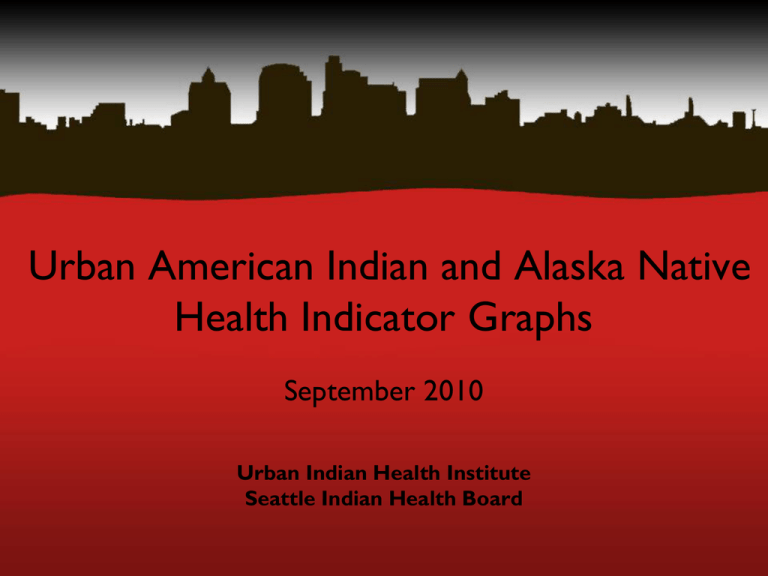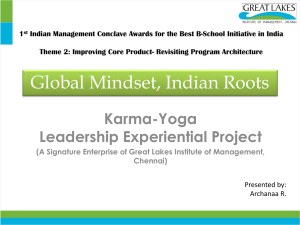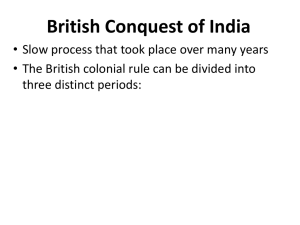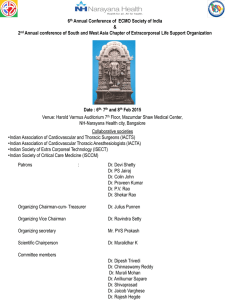
Urban American Indian and Alaska Native
Health Indicator Graphs
September 2010
Urban Indian Health Institute
Seattle Indian Health Board
Introduction
This PowerPoint includes graphs from select Urban
Indian Health Institute (UIHI) reports. These are
intended to be used by urban Indian health
organizations (UIHO) and other partners in grants or
presentations of health status and disparities. More
detailed information on data sources, study populations
and limitations may be obtained by accessing individual
reports online at:
http://www.uihi.org/resources/reports/
Seattle Indian Health Board’s Urban Indian Health Institute
Outline of included UIHI reports
• Community Health Profile (2009)
• Health and Health-Influencing Behaviors among Urban
AI/AN (2008)
• Urban American Indian and Alaska Native Youth (2009)
• Reproductive Health of Urban American Indian and
Alaska Native Women (2010)
• Visibility Through Data (2009)
Seattle Indian Health Board’s Urban Indian Health Institute
REPORT:
Community Health Profile: Urban Indian Health
Organizations (UIHO) Aggregate Urban Counties (2009)
Enclosed Figures:
•
•
•
•
•
•
•
•
•
Percentage of U.S. AI/AN Population Living in Urban Areas
Highest Educational Attainment, 25 and Older
Poverty Status
AI/AN Top Cause Mortality, 2001-2005
AI/AN Cancer Mortality, 2001-2005
Select Mortality Disparities, 2001-2005
Self-Reported Health Status, 2004-2008
Current Smoker, 2004-2008
Obesity (BMI≥30)
Seattle Indian Health Board’s Urban Indian Health Institute
REPORT:
Community Health Profile: Urban Indian Health
Organizations (UIHO) Aggregate Urban Counties (2009)
Enclosed Figures (Cont.):y, 1998-2002
•
•
•
•
•
•
•
•
Diagnosed with Diabetes, 2004-2008
Could Not See a Doctor Because Of Cost, 2004-2008
No Health Insurance, 2004-2008
Smoking During Pregnancy, 1998-2002
Births to Teen Mothers, 2001-2005
Late or No Prenatal Care, 1998-2002
All Cause Infant Mortality, 2000-2004
Infant Mortality due to SIDS, 1995-2004
Seattle Indian Health Board’s Urban Indian Health Institute
Data Sources
• Data include AI/AN living in counties served by the 34 UIHO
compared to all races in the same counties.
• 2000 Census Data
– AI/AN includes people reporting AI/AN alone and AI/AN in combination
with another race.
• Vital Records
– Collection methods for prenatal care and maternal smoking on birth
certificates have recently changed. Data is presented pre-birth certificate
change (1998-2002).
– To protect confidentiality, select indicators (e.g., SIDS) are presented with
more years (1995-2004) so reporting on these indicators is possible.
• Behavioral Risk Factor Surveillance System (BRFSS)
– AI/AN includes individuals who selected AI/AN when asked, “Which one of
these groups would you say best represents your race?”.
Seattle Indian Health Board’s Urban Indian Health Institute
Percentage of U.S. AI/AN Population Living
in Urban Areas
U.S. Census, Urban Areas, United States, 2000
Seattle Indian Health Board’s Urban Indian Health Institute
Highest Educational Attainment, Age 25 and older
U.S. Census, UIHO Service Areas, United States, 2000
Seattle Indian Health Board’s Urban Indian Health Institute
Poverty Status
U.S. Census, UIHO Service Areas, United States, 2000
Seattle Indian Health Board’s Urban Indian Health Institute
Could Not See Doctor Because of Cost
BRFSS, UIHO Service Areas, United States, 2004-2008
Seattle Indian Health Board’s Urban Indian Health Institute
No Health Insurance in Past 12 Months,
BRFSS, UIHO Service Areas, United States, 2004-2008
Seattle Indian Health Board’s Urban Indian Health Institute
AI/AN Top Cause Mortality
U.S. Centers for Health Statistics, UIHO Service Areas, United States, 2001-2005
Seattle Indian Health Board’s Urban Indian Health Institute
AI/AN Cancer Mortality
U.S. Centers for Health Statistics, UIHO Service Areas, United States, 2001-2005
Seattle Indian Health Board’s Urban Indian Health Institute
Select Mortality Disparities
U.S. Centers for Health Statistics, UIHO Service Areas, United States, 2001-2005
Seattle Indian Health Board’s Urban Indian Health Institute
Self-Reported Health Status
BRFSS, UIHO Service Areas, United States, 2004-2008
Seattle Indian Health Board’s Urban Indian Health Institute
Current Smoker
BRFSS, UIHO Service Areas, United States, 2004-2008
Seattle Indian Health Board’s Urban Indian Health Institute
Obesity (BMI ≥ 30)
BRFSS, UIHO Service Areas, United States, 2004-2008
Seattle Indian Health Board’s Urban Indian Health Institute
Diagnosed with Diabetes
BRFSS, UIHO Service Areas, United States, 2004-2008
Seattle Indian Health Board’s Urban Indian Health Institute
Smoking During Pregnancy
U.S. Centers for Health Statistics, UIHO Service Areas, United States, 1998-2002
Seattle Indian Health Board’s Urban Indian Health Institute
Births to Teen Mothers
U.S. Centers for Health Statistics, UIHO Service Areas, United States, 2001-2005
Seattle Indian Health Board’s Urban Indian Health Institute
Late or No Prenatal Care
US Centers for Health Statistics, UIHO Service Areas, United States, 1998-2002
Seattle Indian Health Board’s Urban Indian Health Institute
All Cause Infant Mortality
US Centers for Health Statistics, UIHO Service Areas, United States, 2000-2004
Seattle Indian Health Board’s Urban Indian Health Institute
Infant Mortality due to SIDS
US Centers for Health Statistics, UIHO Service Areas, United States, 1995-2004
Seattle Indian Health Board’s Urban Indian Health Institute
REPORT:
Reported Health and Health-influencing Behaviors
Among Urban American Indians and Alaska
Natives: An analysis of Data Collected by the Behavioral
Risk Factor Surveillance System (2008)
Enclosed Figures:
•
•
•
•
•
Any Alcohol in the Last 30 Days
Binge Drinking Among Those Who Drink Alcohol
No Leisure-time Physical Activity in Past 30 Days
One or More Days of Poor Mental Health in Past 30 Days
One or More Days of Poor Physical Health in Past 30 Days
Seattle Indian Health Board’s Urban Indian Health Institute
REPORT:
Reported Health and Health-influencing Behaviors
Among Urban American Indians and Alaska
Natives: An analysis of Data Collected by the Behavioral
Risk Factor Surveillance System (2008)
Enclosed Figures (cont):
•
•
•
•
•
Eat Five Fruits/Vegetables in a Day
Visit to Dentist for Any Reason in Past Year
Dental Cleaning in Past Year
Ever Told By a Doctor that You Have High Blood Pressure
Ever Test for HIV (Excludes Blood Donation)
Seattle Indian Health Board’s Urban Indian Health Institute
Data Source: Behavioral Risk Factor
Surveillance System (BRFSS)
•
•
•
•
•
National phone-based survey administered annually
This analysis includes BRFSS years 2004-2008
3,273 urban AI/AN; 245,960 urban non-AI/AN
Each year, AI/AN were 1.4%-1.6% of the total sample.
Women made up approximately 60% of the sample among
both groups (AI/AN and non-AI/AN).
• AI/AN respondents were younger as a group than other
respondents (mean age 46 years vs. 52 years).
• Lines show the 95% confidence intervals; all graphs show
statistically significant disparities between groups.
Seattle Indian Health Board’s Urban Indian Health Institute
Any Alcohol in the Past 30 Days
BRFSS, UIHO Service Areas, United States, 2004-2008
Seattle Indian Health Board’s Urban Indian Health Institute
Binge Drinking Among Those Who
Drink Alcohol
BRFSS, UIHO Service Areas, United States, 2004-2008
Seattle Indian Health Board’s Urban Indian Health Institute
No Leisure-Time Physical Activity in
Past 30 Days
BRFSS, UIHO Service Areas, United States, 2004-2008
Seattle Indian Health Board’s Urban Indian Health Institute
One or More Days of Poor Mental
Health in Past 30 Days
BRFSS, UIHO Service Areas, United States, 2004-2008
Seattle Indian Health Board’s Urban Indian Health Institute
One or More Days of Poor Physical
Health in Past 30 Days
BRFSS, UIHO Service Areas, United States, 2004-2008
Seattle Indian Health Board’s Urban Indian Health Institute
Eat Five Fruits/Vegetables Each Day
BRFSS, UIHO Service Areas, United States, 2004-2008
Seattle Indian Health Board’s Urban Indian Health Institute
Visit to Dentist for Any
Reason in Past Year
BRFSS, UIHO Service Areas, United States, 2004-2008
Seattle Indian Health Board’s Urban Indian Health Institute
Dental Cleaning in Past Year
BRFSS, UIHO Service Areas, United States, 2001-2005
Seattle Indian Health Board’s Urban Indian Health Institute
Ever Tested for HIV
(Excludes Blood Donation)
BRFSS, UIHO Service Areas, United States, 2001-2005
Seattle Indian Health Board’s Urban Indian Health Institute
REPORT:
Urban American Indian and Alaska Native Youth:
An Analysis of Select National Data Sources (2009)
Enclosed Figures:
•
•
•
•
•
Leading Causes of Death among AI/AN Youth Aged 15-19 (1999-2001)
Safety and Violence at School (1997-2003)
Reports of Suicidal Behavior (1997-2003)
Reports of Lifetime Illegal Drug Use (1997-2003)
Reports of Sexual Behavior (1997-2003)
Seattle Indian Health Board’s Urban Indian Health Institute
Data Source: Youth Risk Behavior Survey
(YRBS)
• Surveys completed by students in public and private schools
• Data from four survey years were added together and
averaged: 1997, 1999, 2001 and 2003
• Urban is inside a Census-defined Metropolitan Statistical Area
• 59,839 students total in all four survey years
• 513 urban AI/AN; 19,189 urban whites
• Mixed race AI/AN and whites are not included in data
• Participant demographic profiles are not statistically
significantly different.
• All data presented are statistically significant disparities.
Seattle Indian Health Board’s Urban Indian Health Institute
Safety and Violence at School
Youth Risk Behavior Survey, Urban Areas, United States, 1997-2003
Seattle Indian Health Board’s Urban Indian Health Institute
Reports of Suicidal Behavior
Youth Risk Behavior Survey, Urban Areas, United States, 1997-2003
Seattle Indian Health Board’s Urban Indian Health Institute
Reports of Lifetime Illegal Drug Use
Youth Risk Behavior Survey, Urban Areas, United States, 1997-2003
Seattle Indian Health Board’s Urban Indian Health Institute
Reports of Sexual Behavior
Youth Risk Behavior Survey, Urban Areas, United States, 1997-2003
Seattle Indian Health Board’s Urban Indian Health Institute
REPORT:
Reproductive Health of Urban American Indian
and Alaska Native Women: Examining Unintended
Pregnancy, Contraception, Sexual History and Behavior,
and Non-Voluntary Sexual Intercourse (2010)
Enclosed Figures:
•
•
•
•
Current Contraceptive Status
Contraception: Current Use
Depo-Provera Use by Age
Contraceptive Use at First Sex
Seattle Indian Health Board’s Urban Indian Health Institute
•
•
•
Using Any Contraception: 15-19 yrs
Non-Voluntary First Sex
Unintended Pregnancy
Data Source: National Survey of Family
Growth (NSFG)
•
•
•
•
•
•
•
Represents U.S. household population, 15-44 years old
In-person interviews and self-completed surveys are used
Data are from 2002; NSFG survey cycle 6
Urban is inside a Census-defined Metropolitan Statistical Area
7,643 total females included in 2002
299 urban AI/AN; 3,173 non-Hispanic whites (NH-white)
AI/AN reported AI/AN only or AI/AN as the race that best
describes them
• Lines are 95% confidence intervals. Non-overlapping lines are
statistically significant disparities between groups.
Seattle Indian Health Board’s Urban Indian Health Institute
Current Contraceptive Status: AI/AN
NSFG, Urban Areas, United States, 2002
Other
methods, 8%
Depo, 5%
Condom,
13%
Non-use,
38%
Pill, 13%
Female
sterilization,
21%
Seattle Indian Health Board’s Urban Indian Health Institute
Contraception: Current Use
Most Common Methods
NSFG, Urban Areas, United States, 2002
Seattle Indian Health Board’s Urban Indian Health Institute
Depo-Provera Use By Age Groups
NSFG, Urban Areas, United States, 2002
Seattle Indian Health Board’s Urban Indian Health Institute
Use of Any Method of Contraception
at first sexual intercourse
NSFG, Urban Areas, United States, 2002
Seattle Indian Health Board’s Urban Indian Health Institute
Current Use of Any Contraception
15-19 years
NSFG, Urban Areas, United States, 2002
Seattle Indian Health Board’s Urban Indian Health Institute
Non-Voluntary First Sex
NSFG, Urban Areas, United States, 2002
Seattle Indian Health Board’s Urban Indian Health Institute
Unintended Pregnancy
NSFG, Urban Areas, United States, 2002
Seattle Indian Health Board’s Urban Indian Health Institute
Urban Indian Health Institute
Seattle Indian Health Board
P.O. Box 3364
Seattle, WA 98114
Phone: (206) 812-3030
Fax: (206) 812-3044
Email: info@uihi.org
Website: www.uihi.org








